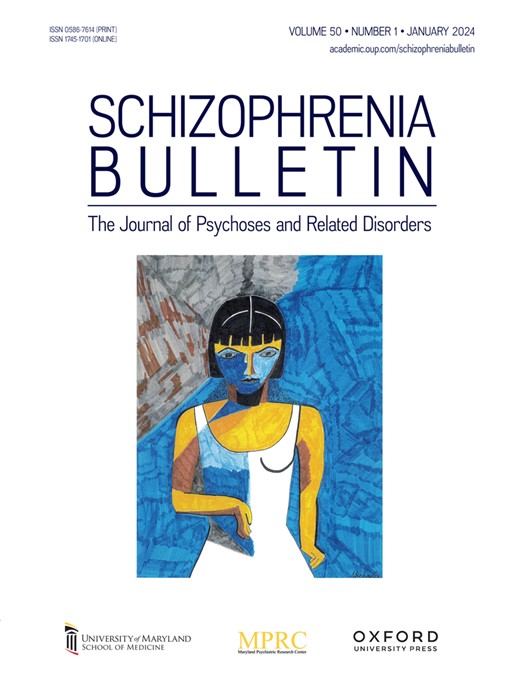Genetic Differences in Reactivity to the Environment Impact Psychotic-Like and Affective Reactivity in Daily Life
IF 5.3
1区 医学
Q1 PSYCHIATRY
引用次数: 0
Abstract
Background and Hypothesis Consistent with diathesis-stress models, psychosis research has focused on genetic moderation of adverse environmental exposures. In contrast, the Differential Susceptibility (DS) model suggests that the same genetic variants that increase risk-inducing effects of adverse experiences also enhance beneficial effects from positive experiences. This study examined whether individuals with high genetic susceptibility to the environment showed differential psychotic-like and affective reactivity in response to positive and negative events in daily life. Study Design Experience sampling methodology assessed context (positive and stressful) and momentary levels of paranoia, psychotic-like experiences (PLE), and positive (PA) and negative affect (NA) in 217 non-clinical adults oversampled for schizotypy. Linear mixed models examined whether Polygenic Risk Scores of Environmental Sensitivity (PRS-ES) moderated the impact of current context on subsequent experiences. Study Results PRS-ES moderated positive, but not stressful, context on subsequent levels of momentary paranoia, NA, and PA, but not PLE. Genetic and environmental (G × E) interactions indicated diathesis-stress at lower thresholds of PRS-ES, but a DS model at the highest threshold of the PRS-ES. Participants with elevated PRS-ES showed increased paranoia and NA and decreased PA in subsequent assessments when reporting low levels of positive situations, but also decreased paranoia and NA and increased PA when rating contexts as positive. Conclusions Findings support the influence of genetic sensitivity to the environment on psychotic-like and affective reactivity in daily life, particularly in response to positive contexts. This highlights the transdiagnostic protective role of positive experiences and informs ecological momentary interventions.对环境反应的遗传差异影响日常生活中精神样反应和情感反应
背景与假设与素质-应激模型一致,精神病研究的重点是不良环境暴露的遗传调节。相反,差异易感性(DS)模型表明,增加不良经历的风险诱导效应的相同遗传变异也会增强积极经历的有益效应。本研究考察了对环境具有高遗传易感性的个体在日常生活中对积极和消极事件的反应中是否表现出不同的精神样反应和情感反应。研究设计经验抽样方法评估了217名非临床分裂型成人的环境(积极和压力)和偏执、精神样经历(PLE)、积极(PA)和消极影响(NA)的瞬间水平。线性混合模型检验了环境敏感性多基因风险评分(PRS-ES)是否调节了当前环境对后续体验的影响。研究结果:PRS-ES在随后的瞬间偏执狂、NA和PA水平上调节了积极情境,但没有调节压力情境,但没有调节PLE。遗传和环境(gxe)互作表明,在PRS-ES的较低阈值处存在素质-胁迫,而在PRS-ES的最高阈值处存在DS模型。当报告低水平的积极情境时,PRS-ES升高的参与者在随后的评估中表现出偏执和NA的增加,PA的减少,但当将情境评为积极情境时,偏执和NA的减少和PA的增加。研究结果支持遗传敏感性对日常生活中精神病样反应和情感反应的影响,特别是对积极环境的反应。这突出了积极体验的跨诊断保护作用,并为生态瞬时干预提供了信息。
本文章由计算机程序翻译,如有差异,请以英文原文为准。
求助全文
约1分钟内获得全文
求助全文
来源期刊

Schizophrenia Bulletin
医学-精神病学
CiteScore
11.40
自引率
6.10%
发文量
163
审稿时长
4-8 weeks
期刊介绍:
Schizophrenia Bulletin seeks to review recent developments and empirically based hypotheses regarding the etiology and treatment of schizophrenia. We view the field as broad and deep, and will publish new knowledge ranging from the molecular basis to social and cultural factors. We will give new emphasis to translational reports which simultaneously highlight basic neurobiological mechanisms and clinical manifestations. Some of the Bulletin content is invited as special features or manuscripts organized as a theme by special guest editors. Most pages of the Bulletin are devoted to unsolicited manuscripts of high quality that report original data or where we can provide a special venue for a major study or workshop report. Supplement issues are sometimes provided for manuscripts reporting from a recent conference.
 求助内容:
求助内容: 应助结果提醒方式:
应助结果提醒方式:


